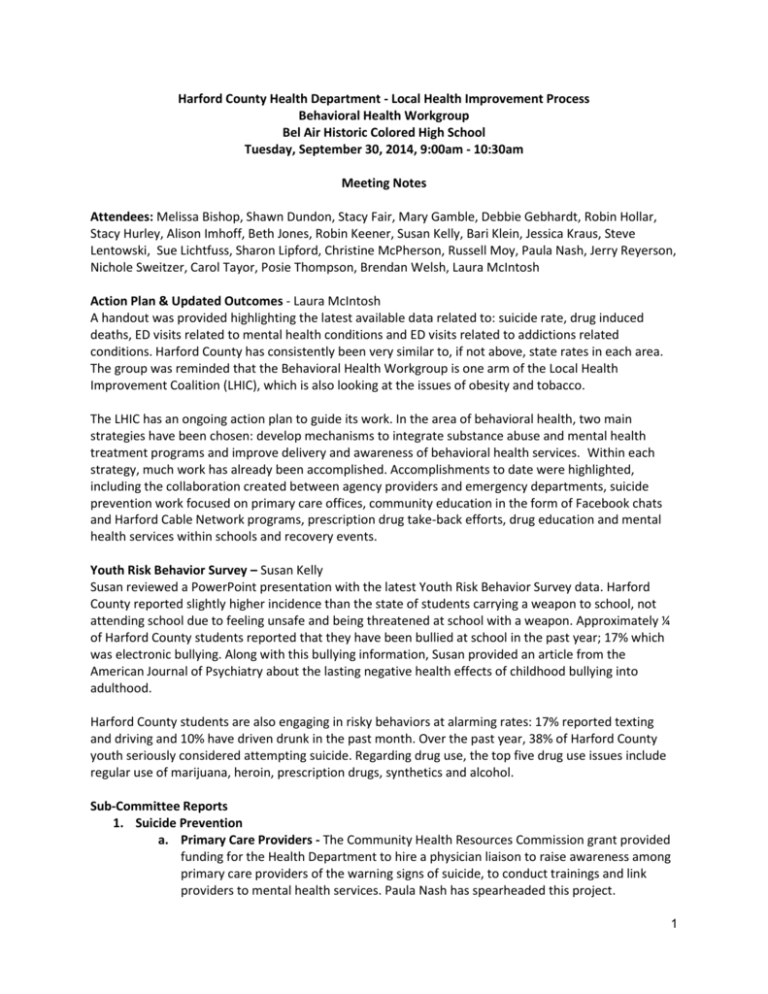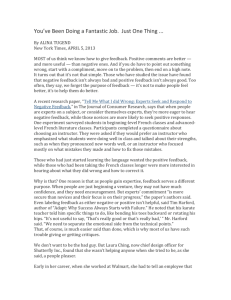HARFORD COUNTY HEALTH DEPARTMENT
advertisement

Harford County Health Department - Local Health Improvement Process Behavioral Health Workgroup Bel Air Historic Colored High School Tuesday, September 30, 2014, 9:00am - 10:30am Meeting Notes Attendees: Melissa Bishop, Shawn Dundon, Stacy Fair, Mary Gamble, Debbie Gebhardt, Robin Hollar, Stacy Hurley, Alison Imhoff, Beth Jones, Robin Keener, Susan Kelly, Bari Klein, Jessica Kraus, Steve Lentowski, Sue Lichtfuss, Sharon Lipford, Christine McPherson, Russell Moy, Paula Nash, Jerry Reyerson, Nichole Sweitzer, Carol Tayor, Posie Thompson, Brendan Welsh, Laura McIntosh Action Plan & Updated Outcomes - Laura McIntosh A handout was provided highlighting the latest available data related to: suicide rate, drug induced deaths, ED visits related to mental health conditions and ED visits related to addictions related conditions. Harford County has consistently been very similar to, if not above, state rates in each area. The group was reminded that the Behavioral Health Workgroup is one arm of the Local Health Improvement Coalition (LHIC), which is also looking at the issues of obesity and tobacco. The LHIC has an ongoing action plan to guide its work. In the area of behavioral health, two main strategies have been chosen: develop mechanisms to integrate substance abuse and mental health treatment programs and improve delivery and awareness of behavioral health services. Within each strategy, much work has already been accomplished. Accomplishments to date were highlighted, including the collaboration created between agency providers and emergency departments, suicide prevention work focused on primary care offices, community education in the form of Facebook chats and Harford Cable Network programs, prescription drug take-back efforts, drug education and mental health services within schools and recovery events. Youth Risk Behavior Survey – Susan Kelly Susan reviewed a PowerPoint presentation with the latest Youth Risk Behavior Survey data. Harford County reported slightly higher incidence than the state of students carrying a weapon to school, not attending school due to feeling unsafe and being threatened at school with a weapon. Approximately ¼ of Harford County students reported that they have been bullied at school in the past year; 17% which was electronic bullying. Along with this bullying information, Susan provided an article from the American Journal of Psychiatry about the lasting negative health effects of childhood bullying into adulthood. Harford County students are also engaging in risky behaviors at alarming rates: 17% reported texting and driving and 10% have driven drunk in the past month. Over the past year, 38% of Harford County youth seriously considered attempting suicide. Regarding drug use, the top five drug use issues include regular use of marijuana, heroin, prescription drugs, synthetics and alcohol. Sub-Committee Reports 1. Suicide Prevention a. Primary Care Providers - The Community Health Resources Commission grant provided funding for the Health Department to hire a physician liaison to raise awareness among primary care providers of the warning signs of suicide, to conduct trainings and link providers to mental health services. Paula Nash has spearheaded this project. 1 b. Pediatricians – The second phase of this project will target pediatricians. c. BHA/Federal Grant – The State’s Behavioral Health Administration is applying for a SAMHSA grant which will include suicide prevention. They have been made aware of our local efforts, which could be supported by this grant, if funded. d. School Suicide Prevention – Joe Ryan is partnering with private schools, including John Carroll and local churches to target youth with suicide prevention messages, such as the Yellow Ribbon Project. 2. Community/Outreach & Prevention a. Run 4 Recovery (Brendan Welsh) - Held 9/6/14 by the Health Department’s Division of Behavioral Health (DBH). This first time event had over 100 participants and raised $1,000 for Addiction Connections Resource. b. Candlelight Vigil, Anonymous People – 250 attendees participated in the vigil led by Pastor McLaughlin of Mt. Zion Methodist Church in Bel Air, in memory of his daughter who passed away from a drug overdose. c. Social Media Campaign – The Office of Drug Control Policy will be utilizing funding from a MD Alcohol and Drug Abuse Administration grant to hire an outreach coordinator to spearhead communications targeted to youth. 3. Health Department – Beth Jones a. Vivitrol Initiative – Program will be available at the detention center which provides a shot to inmates prior to release to block the effects of alcohol and opiates for 30 days. This window of time will be used to get the individual linked with ongoing addiction treatment. b. Expansion of MH Services – OMHC – The Health Department was approved as an Outpatient Mental Health Clinic on 8/5/14. The Division of Addictions will now be referred to as the Division of Behavioral Health. c. Naloxone Trainings – The Health Department became a training entity for Naloxone Training and Certification Program in May, 2014. To date, 302 individuals have been trained on how to utilize Naloxone to reverse the effects of an overdose. Trainings are free and offered the first Thursday of every month. With the assistance of the training and kit provided, one overdose has been reversed. d. Overdose Fatality Review Team – The Health Department, in collaboration with community partners, soon will initiate a county Local Overdose Fatality Review Team. The review team will promote cooperation and coordination among agencies involved in investigations of drug overdose deaths, and make recommendations within agencies in an effort to prevent future deaths. Community Programs/Initiatives: 1. Mobile Crisis Team Updates (Sue Lichtfuss) – Mobile Crisis is available 7 days a week, 8:00ammidnight (schedule was expanded in March). Every Wednesday Mobile Crisis offers community education on different topics. People can self-refer, and sign up by calling Mobile Crisis. Urgent psychiatric assessment appointments are available Tuesdays and Thursdays and help link people to needed medication quickly. Appointments for a psychiatrist can take 3 months or more. 2. CIT – Statewide Update, Booster Training (Shawn Dundon) – The MD State Training Commission is setting a standardized training model for law enforcement related to mental health needs. Trainings include Mental Health First Aid and Crisis Intervention Team (CIT) Training. There are now 6 coordinators around the state, including Shawn. Coordinators will be attending an International Training Conference this October in California. Yesterday, a CIT Booster training 2 3. 4. 5. 6. 7. was held for 22 correctional and patrol officers to provide a CIT refresher. One of the presenters was from the Alzheimer’s Association. Shawn handed out the association’s brochure. Hospital Emergency Collaboration (Jessica Kraus) – Quarterly meetings are held between mental health providers, emergency room staff, CIT, Mobile Crisis and the Office on Mental Health to discuss strategies to get the right people in and out of inpatient services at the hospital. The group works to make sure hospital staff are aware of resources to refer patients to at the point of discharge. Open communication between providers is a continual theme. The group also plans to look regionally and include Cecil County providers. The next meeting will be in December, and all are welcome to attend. Detention Center Behavioral Health Unit (BHU) – Mary Gamble, of the Department of Community Services, is working at the Detention Center’s BHU. Mary explained that 2/3 of inmates meet the criteria for a mental health disorder. The BHU is a treatment unit at the jail for men. Individual and group therapy are provided as well as planning around resource connections prior to an inmate’s release. Office of Drug Control Policy – Robin Hollar has been hired as the new Drug Court Coordinator. Robin will oversee the 5 specialty courts – Mental Health, DUI, Juvenile Drug Court, Family Recovery Court and Adult Drug Court. She will be looking into evidence based programs to support development of the drug courts. School Based Mental Health – A small workgroup is examining the current School Based Mental Health structure and looking at Youth Risk Behavior Data to see if the program should continue as is, or have potential improvements made with the support of Local Management Board dollars. Newborn Drug Exposure MOU – The Department of Social Services (DSS) and Upper Chesapeake are collaborating on an MOU to review cases of substance exposed newborns. DSS has seen a rising number of referrals from the hospital. This MOU will help improve communication between the agencies. New Areas of Focus: Faith Communities Health Project - Dr. Moy Spurred by a comment made by a local pastor at the Tobacco and Cancer Joint Coalition meeting that the county needs more parish (or faith community) nurses, the Health Department is interested in collaborating with faith based organizations to help them address health needs within their congregations. The Department is applying for a grant through the Maryland Cancer Fund that would allow it to give mini-grants to local churches with minority populations, as racial disparities exist in the County for cancer and many other health issues. The end result would be the sharing of best practices among churches to spread enthusiasm for health ministries. This model would lend itself to addressing all health issues, including stress and behavioral health needs. Carol Taylor echoed the need to utilize churches to reach members of the community. People listen to their pastors and pastors want to partner with professionals. Pastors need to first buy into health and wellness themselves, and then they can model it to their congregation. Carol noted that she is seeing a rise in behavioral health issues, especially among youth. Preventative care needs to be instilled into the current generation, especially among minority groups. Aging Summit - Sharon Lipford The County hosted the second annual Aging Summit last week and a major focus of the conversation revolved around the need for behavioral health services. Many providers do not accept Medicare and it 3 is hard to get an appointment. The senior population is growing faster than other subsets of the population. Sharon called for a discussion around how we can address these needs. Issues: Health Care Reform is still new and difficult to navigate Lack of knowledge of resources Lack of family support for many seniors (competent but not capable) Language diversity Getting releases signed to be able to speak to informal supports Ideas: Tap into families, friends, neighbors who could advocate on the seniors behalf. Also look to their faith community. Look into Rep Payee Programs, where volunteers help manage the individuals finances, such as paying bills. St. Margaret’s may still offer this service. Alliance’s ACT program offers this service as well (they offer wraparound care including help with housing, transportation, etc.) Office on Aging has a MAP Intake Coordinator, Anne Cerruto LASOS has office hours Monday through Saturday and has bilingual staff on hand to help translate Spanish, with access to interpreting 72 other languages as well. Families become members of LASOS for free and are provided with resource connection/case management. Call 410-836-0333. Suggestion to add a housing representative to this workgroup to answer questions about how to help seniors with housing/assistive living. Link with the Hospital’s Population Health initiative that is focused on linking patients with community based services. The Federally Qualified Health Center (FQHC) Beacon Health will open an office in Harford County late fall/early winter, and will offer behavioral health services. A model from California was suggested called “Case Management without Walls” where the hospital sets up case managers in the community to do follow up with discharged patients. Partner with Harford Community College to offer trainings on how to effectively speak with seniors and link them with care. A skilled occupational therapist can help assess the level of supervision needed for a senior Tele-Medicine Idea of tele-medicine came from the suicide prevention initiative. If primary care providers are going to screen for suicide, they need to have access to mental health resources to refer to. Howard County has received an MSDE grant to offer tele-medicine as part of school-based mental health. It is very expensive. University of Maryland Upper Chesapeake Health is working on a grant that would link Lorien Assistive Living and the emergency department through tele-medicine. Dr. Moy noted that the State of Maryland has applied for a Federal State Innovation Model (SIM) grant which, if awarded, would be distributed through regional hubs, to begin in 2015. These are the type of ideas we need to have ready in order to be able to apply and keep the money as close to Harford County as possible. Upcoming Events 10/11 - LASOS Bingo, 6:30pm, Bel Air Armory 4 10/20 - Health Department’s Local Health Improvement Coalition Annual Meeting, 12pm-4pm, Kaufman Cancer Center, RSVP laura.mcintosh@maryland.gov 10/23 - Pastor and Community Networking Summit, 4pm, Edgewood Senior Center 11/1 - Alzheimer’s Association Walk, Bel Air - http://alz.org/maryland/ 11/7 - Harford County Trauma Institute, Church of the Nazarene, www.harfordcountytraumainstitute.com 5





